The numbers are in. The best time to send email newsletters in 2025 is…
 CEO, Indre, and SEO team lead, Paulius, testing email send times together
CEO, Indre, and SEO team lead, Paulius, testing email send times together
What is the best time to send emails in 2025? This is one of the most common questions we get, so we dove into our own data to shed some light and find answers.
With that said, is there a time when your subscribers are perfectly primed and ready to receive your email? And if this ‘perfect time’ does exist, wouldn’t everyone be sending their newsletters at exactly the same time, defeating the purpose of trying to stand out in the inbox?
Let’s see exactly what the data says so you can make informed decisions about when to best show up in your subscribers’ inbox. In this article we’ll cover:
The best day to send email campaigns
The best time of day to send your email campaigns
The best days to send an email based on your industry
What email marketing tools and strategies you can use to improve your open rates
But before we get into all of that, how did we come to these conclusions?
Our data: How we gathered it and what it means
We analyzed over a million email marketing campaigns (1,736,519 to be exact!) sent through MailerLite from the US, UK, Australia, and Canada between December 1, 2023 and December 1, 2024. The aim of the study was to identify the optimum times to send emails in 2025 based on user engagement metrics of the previous 12 months. The analysis includes insights into the best days and times to send email campaigns across various countries and industries.
Key Metrics Explained
• Sent campaigns: Number of campaigns successfully sent to recipients
• Total opens: Total number of emails opened by recipients
• Total open rate: Proportion of total opens to emails sent across all campaigns (weighted average)
• Average open rate: Average open rate across individual campaigns (equal weight)
Now let’s jump right into the key insights we gathered from this data.
TL;DR: What does the data say about the best time to send an email campaign?
We wanted to use our data to find out which day marketers typically send email campaigns, which day generates the highest open rates, and what time of day sees the highest number of opens.
Here’s a summary of what we found.
Which day of the week is everyone sending their campaigns?
Email marketers favor Thursday (closely followed by Friday) for sending out their campaigns.
Which day of the week generates the most opens?
Monday is the weekday with the highest average open rate (51.90%), closely followed by Tuesday (51%)
Sunday also generated a high amount of average opens (51.28%). However weekends have a significantly lower campaign volume which may have skewed the data
What time of the day generates the most opens?
During weekdays, the highest engagement falls between 3 PM to 7 PM local time once we exclude outliers
On weekends, campaigns sent around 9 AM have higher open rates, though fewer campaigns are sent during this time
General summary of findings
Weekdays outperform weekends in terms of total campaigns sent and total opens
Campaigns sent on Mondays have higher-than-average open rates
Timing is crucial: Emails sent in the early morning on weekends and mid-to-late afternoon on weekdays get better results
Focusing campaigns on weekdays rather than weekends is generally more effective due to higher overall engagement and campaign activity
But as you’ll read in this article, it’s important to base your sending times on your specific subscribers' preferences. And when in doubt, test and learn!
What’s the best time to send an email, based on the day and open rates?
Want to know when your fellow marketers are sending out their campaigns? Here's a breakdown of the most popular sending days.
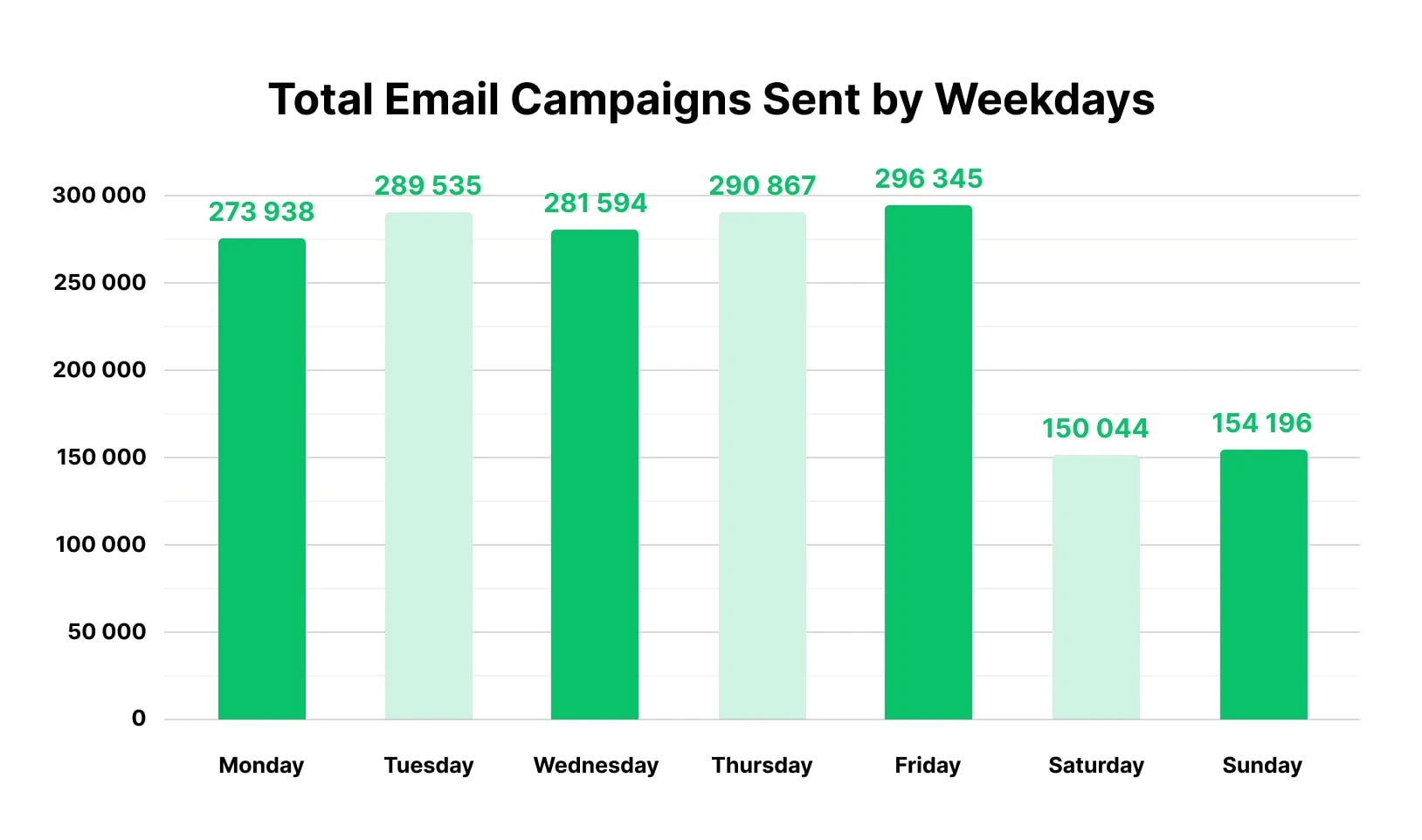
Ta-da! The data shows that most newsletters are sent out on weekdays. Thursday and Friday are the most popular days for email marketers to send out their campaigns. Saturday and Sunday bring up the rear as the least popular (awww, bless them 💔).
Now let's see the average open rates by weekday.
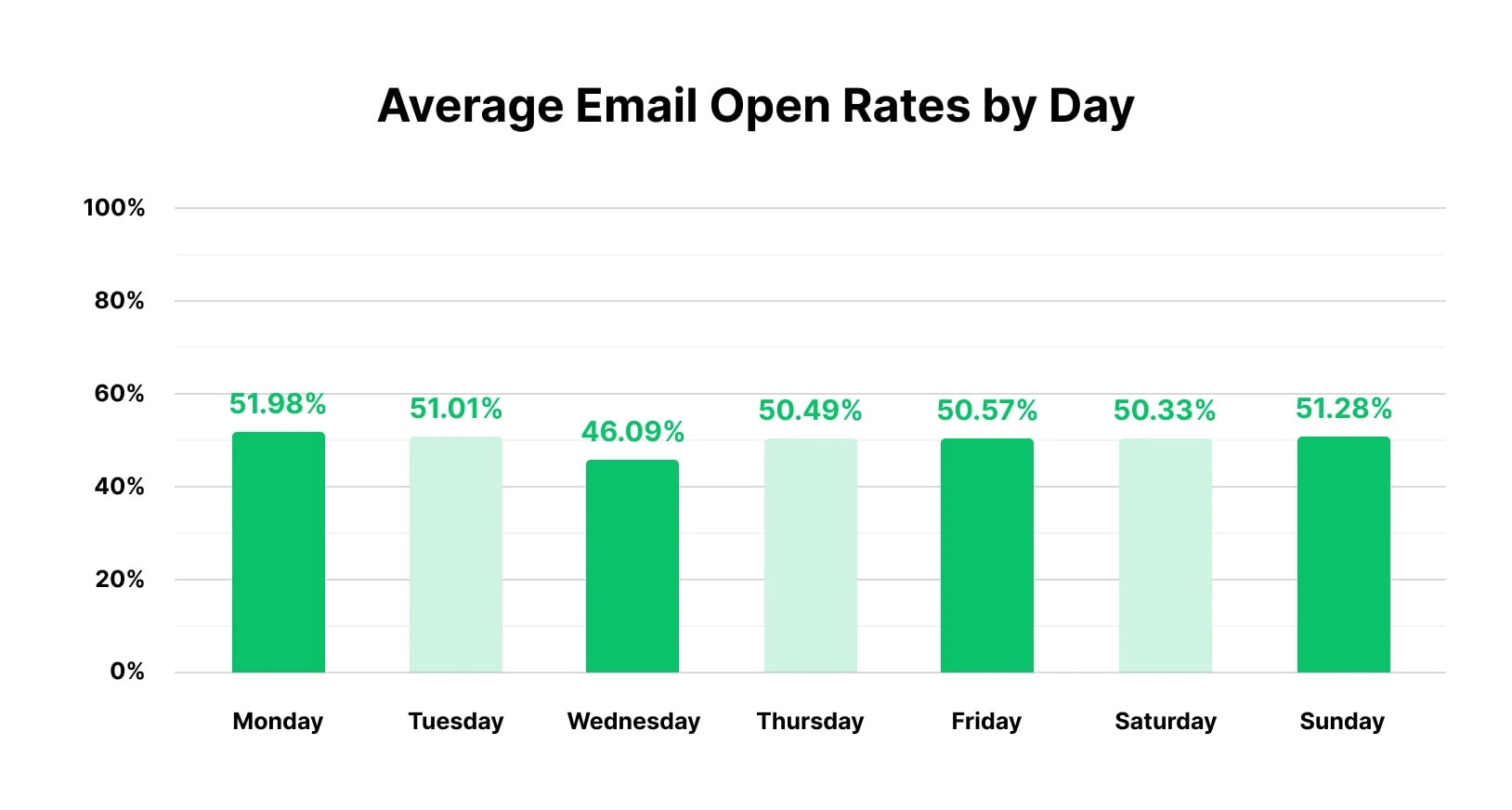
Reassuringly, open rates are pretty consistent across the week, with a dip on Wednesdays (are we all a bit fed up on hump day?). What’s surprising is the high average open rates during the weekend but bear in mind that far fewer emails are sent on Saturdays and Sundays, and not all open rates were created equal. Subscribers might open their emails during the weekend, but may be more likely to take action during the week.
For a more holistic view of overall campaign performance, we analyzed the total open rate—where all campaigns in the data set, regardless of size, contribute equally to the total open rate. This year saw much more evenly distributed total open rates during the week.

The most favorable options are Monday (47.3% total open rate) and Tuesday (46.22% total open rate). We’re hesitant to put too much stock on Sunday’s higher total open rates as significantly fewer campaigns were sent out on a Sunday. Having said that, it might be worth a test to see if it works for your audience! With more emails being sent during the weekdays, you could take the opportunity to stand out from the crowd by sending your campaigns on the weekend and see how you perform.
What’s the best send time?
To answer this question, let’s take a look at the highest average open rates for each day of the week.
Monday: 4 PM with an average open rate of 53.4%
Tuesday: 6 PM with an average open rate of 52.3%
Wednesday: 4 PM with an average open rate of 52.2%
Thursday: 7 PM with an average open rate of 52.5%
Friday: 6 PM with an average open rate of 52.7%
Saturday: 7 AM and 9 AM with an average open rate of 49.1%
Sunday: 9 AM with an average open rate of 49.6%
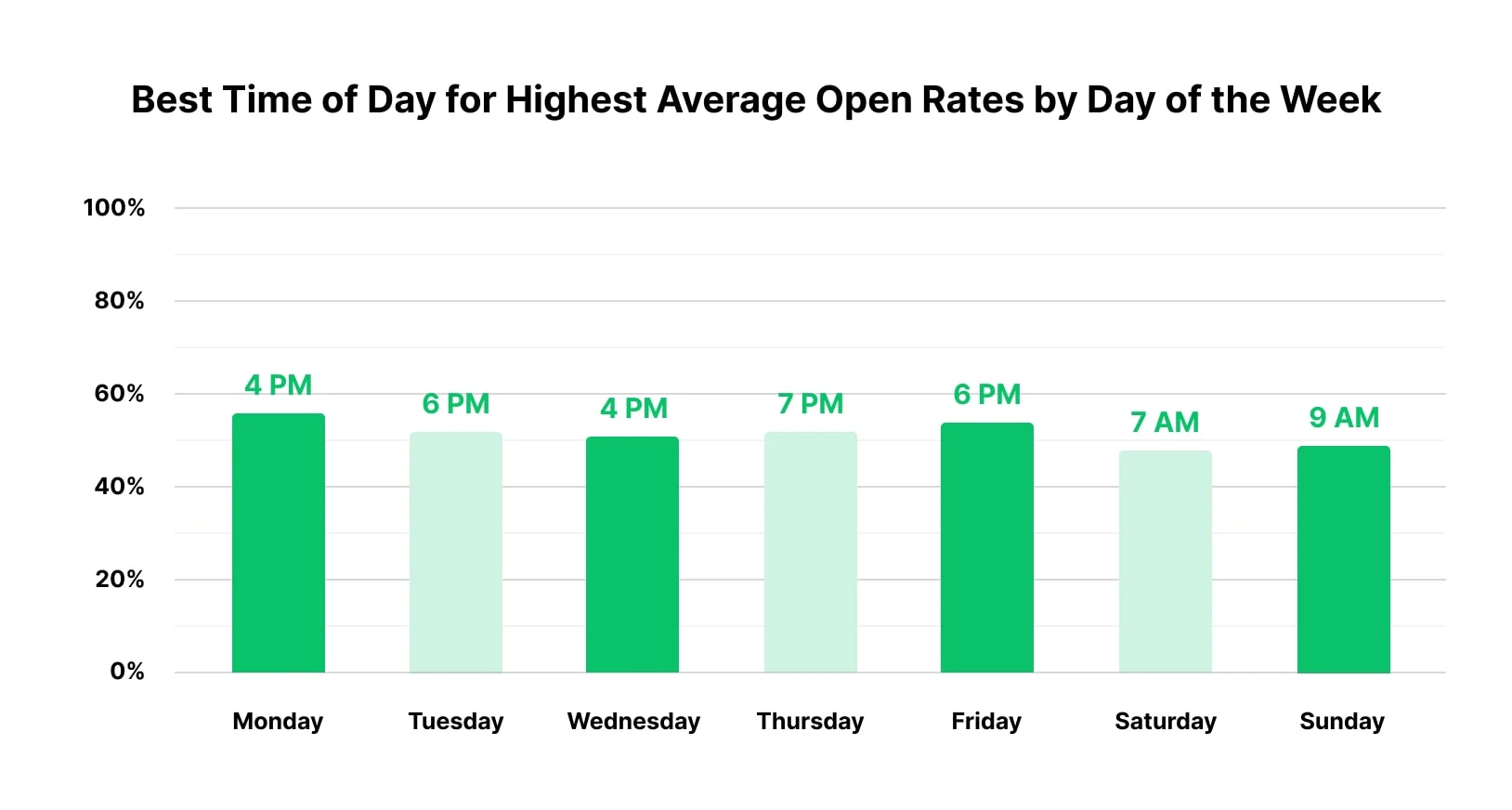
During weekdays, the highest engagement falls between 3 PM and 7 PM local time once we exclude outliers.
On weekends, campaigns sent around 7-9 AM have higher open rates, though fewer campaigns are sent during this time making the data less reliable.
Many industry experts have hailed 10 AM-12 PM as a prime sending window, as your subscribers have settled into their day, but are not yet too focused on their daily tasks to ignore their inboxes. But this year’s data suggests that subscribers are typically tuning into marketing emails and their inboxes after working hours.
Not sure what time of day works for your audiences? Use MailerLite’s Smart sending feature to analyze your subscribers’ behavior and automatically deliver emails at the optimal time.
Smart sending is an advanced tool that uses historical data to determine the best send time for each subscriber. It continues to learn and adapt to your readers’ habits.
When you click to send with Smarting sending, your campaign is automatically broken down into batches and each subscriber receives the newsletter at the time they’re most likely to open and interact with it. No guesswork based on other people’s data. Just results driven by your very own audience.
Best time to send an email on a Monday
According to the data, 4 PM is the peak time when people open their emails on a Monday with an average open rate of 53.4% that stays quite consistent right up until 6 PM. This is likely when your subscribers have finished or are finishing work for the day and are checking their emails before they head off.
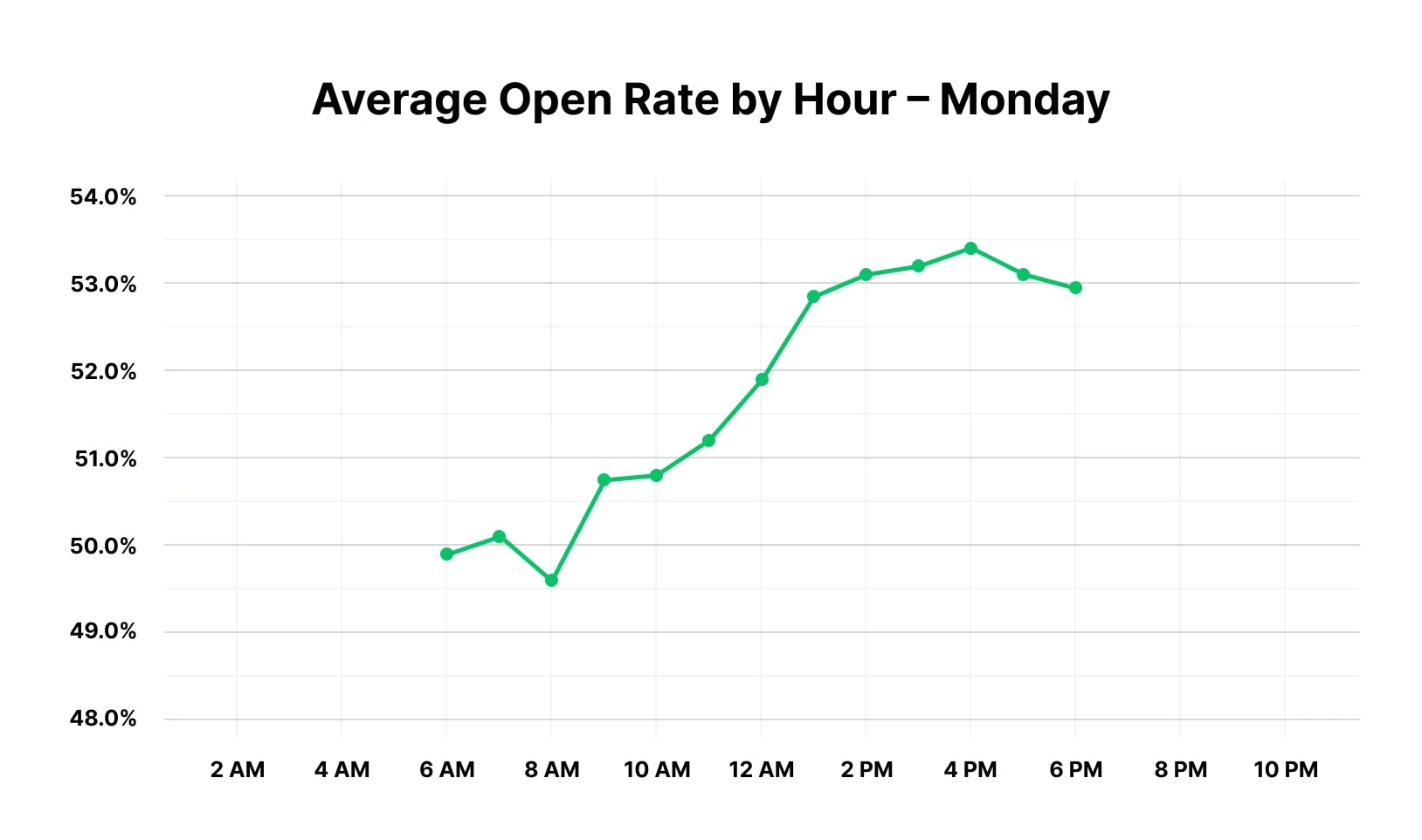
Best time to send an email on a Tuesday
On Tuesdays, email opens start off slow, with fewer subscribers checking their emails in the morning when compared with Monday. Opens peak at 6 PM with an average open rate of 52.3%.
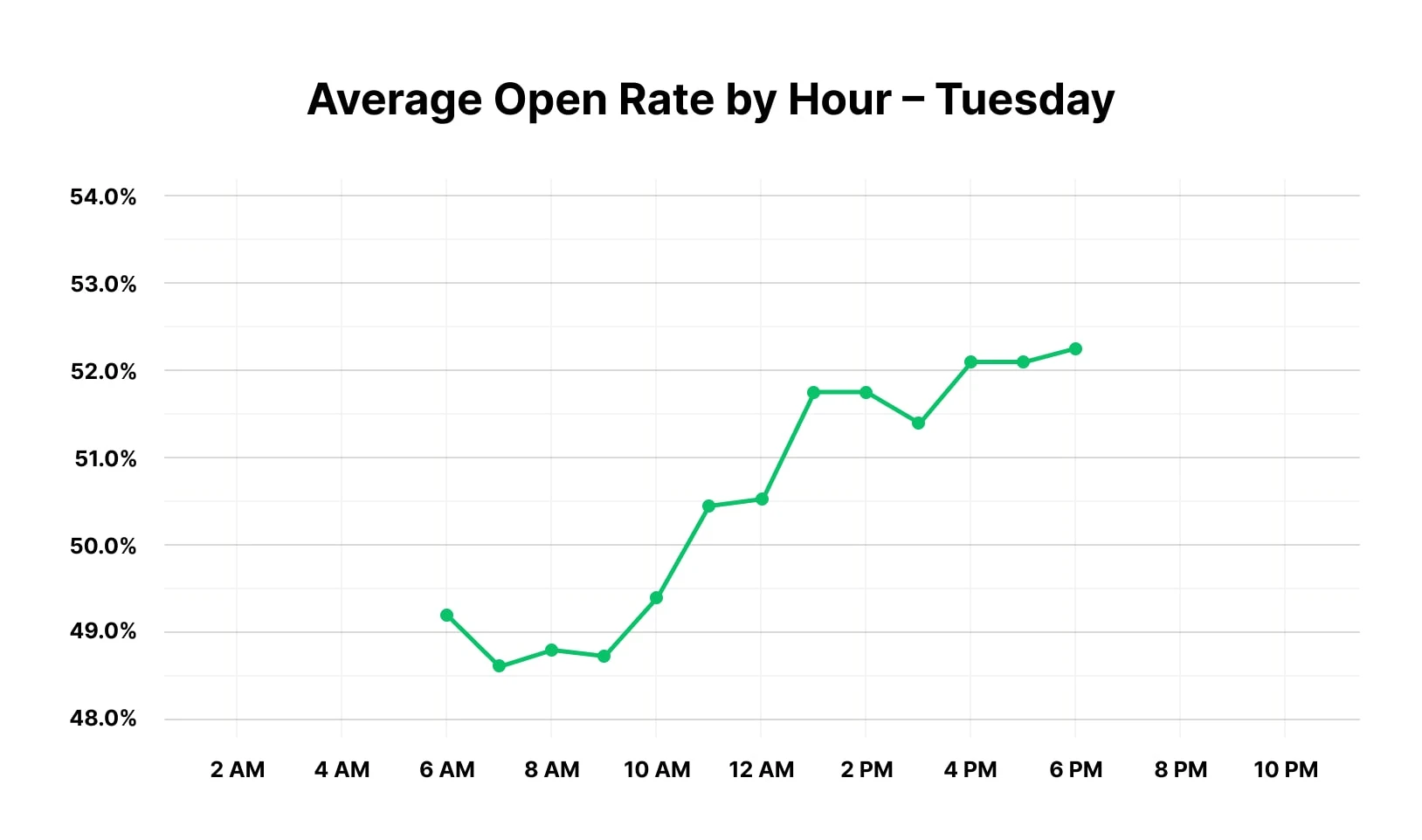
Best time to send an email on a Wednesday
4 PM takes the gold medal again with an average open rate of 52.2%. Wednesday’s open rates follow a similar pattern to Tuesday, with lower opens in the morning that pick up in the afternoon and stay consistent through the evening.
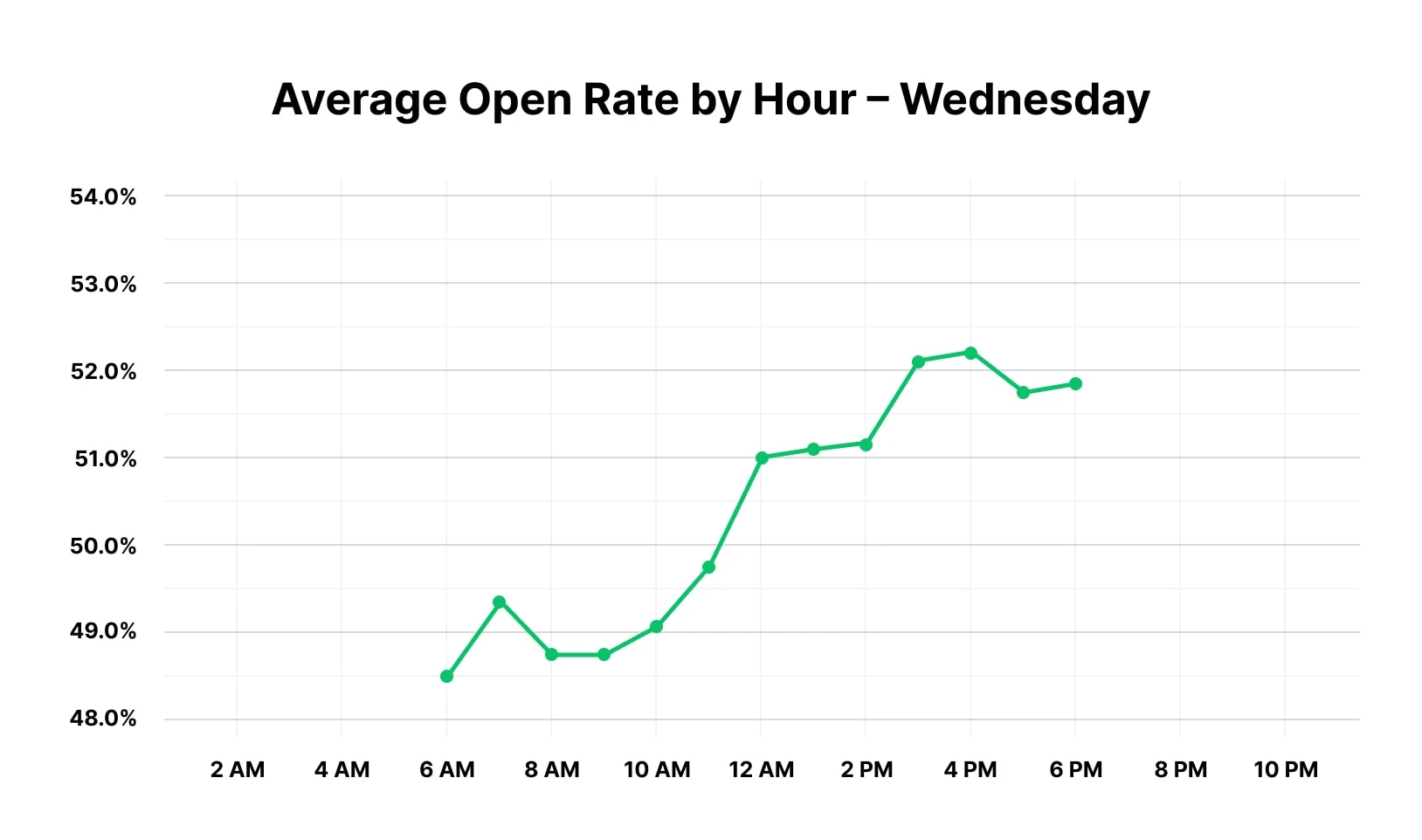
Best time to send an email on a Thursday
Thursday starts to attract later openers with 7 PM taking first place for the time with highest average open rates (52.5%). Thursday also sees an quirky boost of early open rates around 6 AM that drop again throughout the morning and pick up after 9 AM. Open rates start to increase around 3 PM and stay steady throughout the evening.
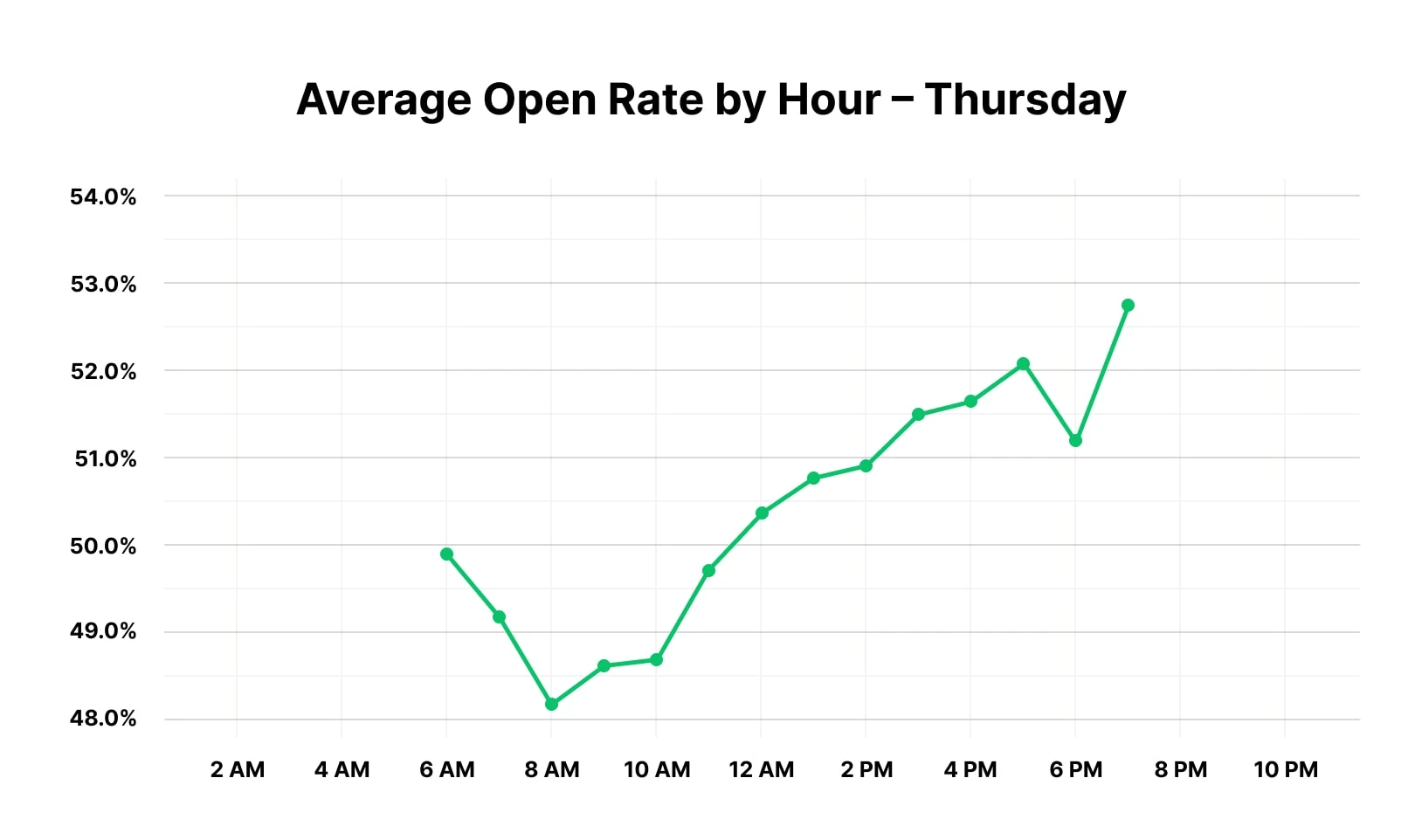
Best time to send an email on a Friday
On Friday mornings, engagement is notably lower compared to the peak at 6 PM (with an average open rate of 52.7%). While there’s steady activity during earlier hours, the open rates gradually increase throughout the day, reaching their highest during the late afternoon and evening. This trend suggests that audiences are more likely to engage with emails later in the day on Fridays, likely as they wind down their workweek and transition into the weekend.
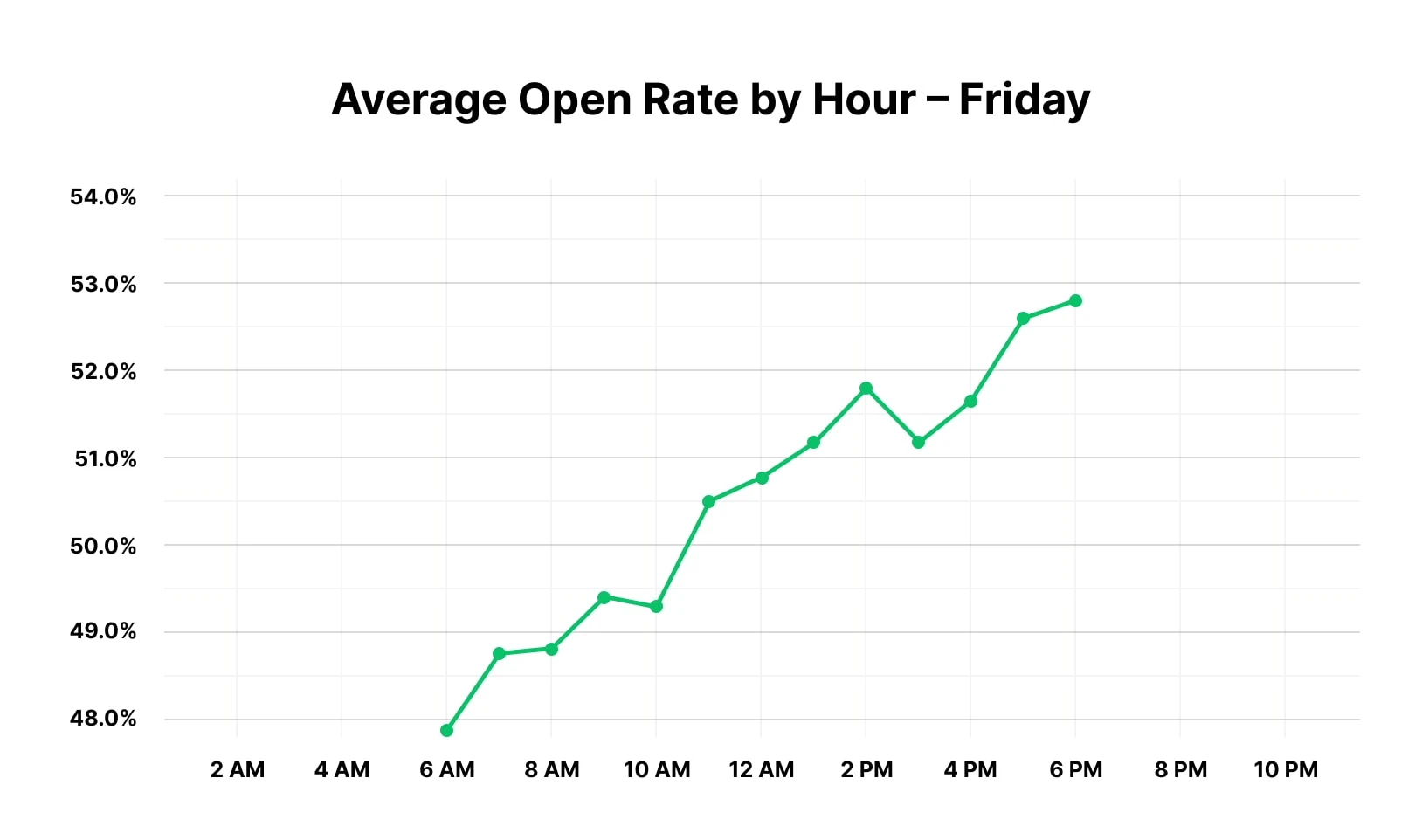
Best time to send an email on a Saturday
The best time to send emails on a Saturday is inverted when compared to weekdays with higher peaks in the morning. Surprisingly, 7 AM saw the biggest spike in average open rates (49.1%).
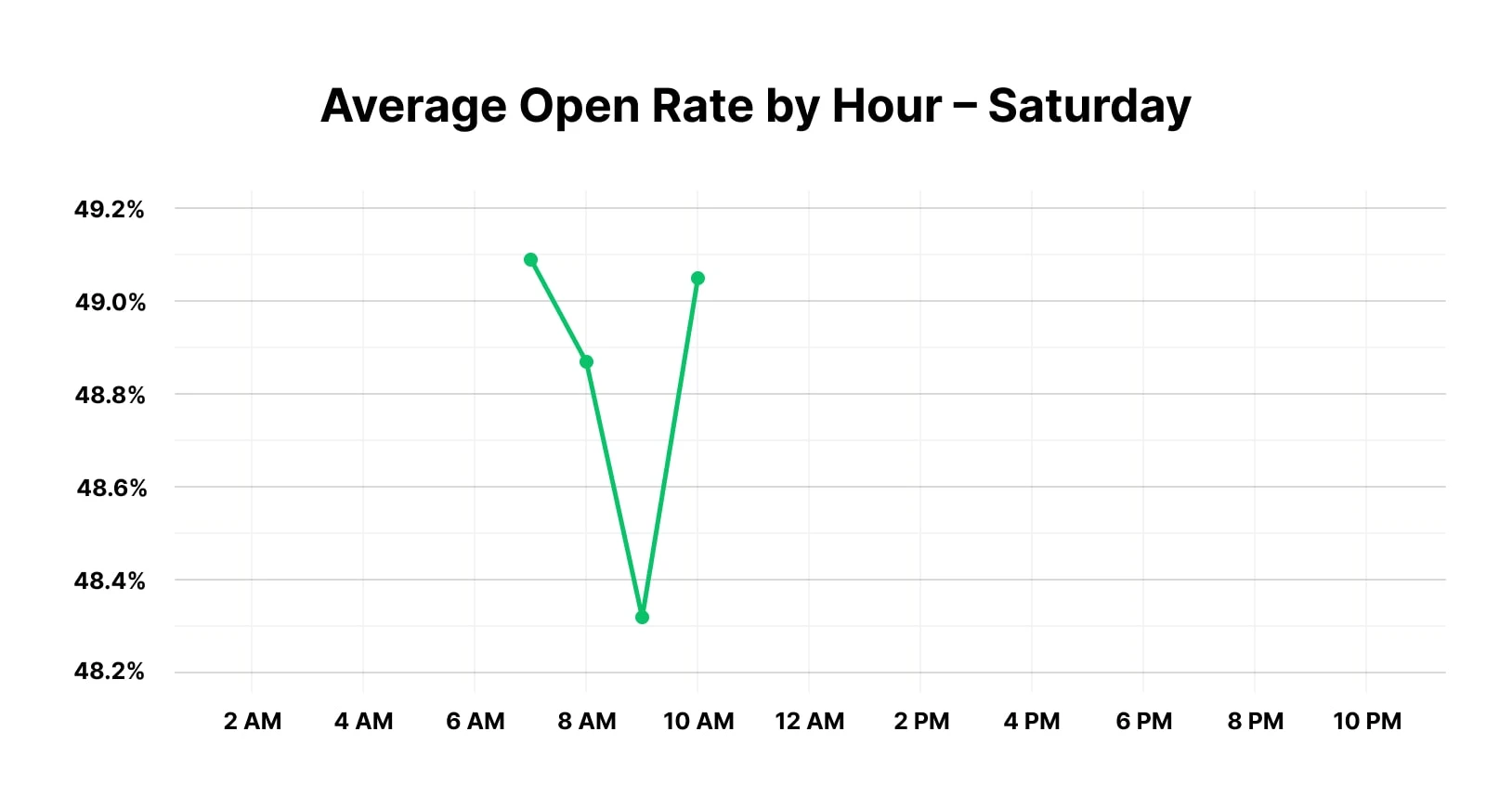
Best time to send an email on a Sunday
Like Saturday, Sunday saw the most engagement in the morning, but a little later at 9 AM. As with Saturday though, the total number of campaigns sent out during the weekend was much lower so this can affect the reliability of the data.
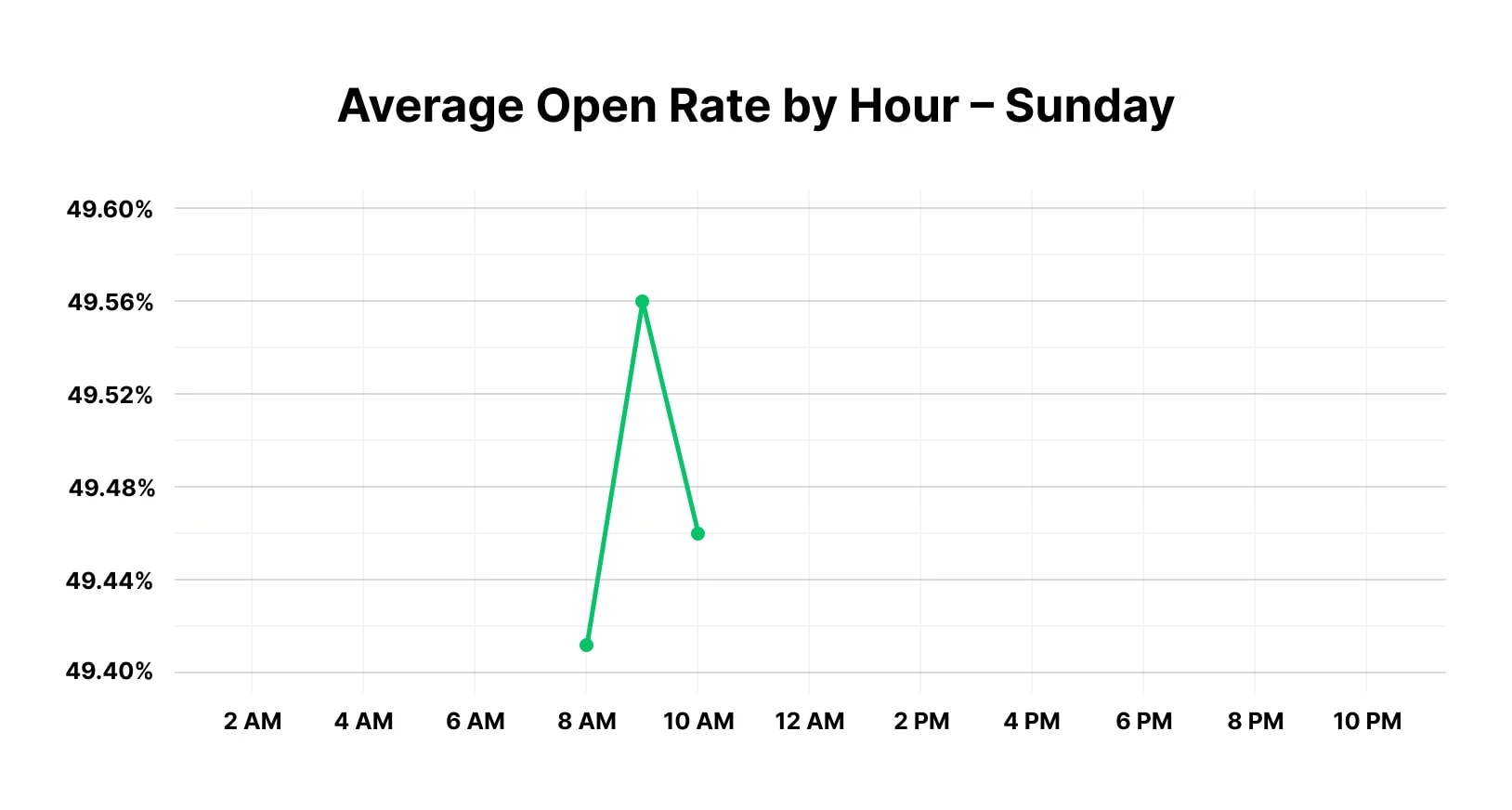
If you're not sure about whether or not to send on the weekend, the simplest way to find out if it’s the right move is to run some tests and experiment.
The best time to send an email by industry
This year we wanted to identify sending trends across specific industries. We collated this data by filtering it by the various industry types associated with our customers’ accounts. The categories include:
Creators (authors, course creators, bloggers, YouTubers, etc.)
SMBs (local businesses, service providers, e-commerce stores, etc.)
Institutions (higher ed, government, non-profit, etc.)
The best day for creators to send an email campaign is…
Monday with a 51.99% average open rate! Creators’ audiences follow the same general trend we’ve seen across industries which shows a boost in email opens on Monday. We see a slight dip on Saturdays, but overall the open rates for creators is quite consistent throughout the week. We also found that creators’ email campaigns got slightly higher overall open rates than other industries, suggesting that a more personal touch to email content could perform better.
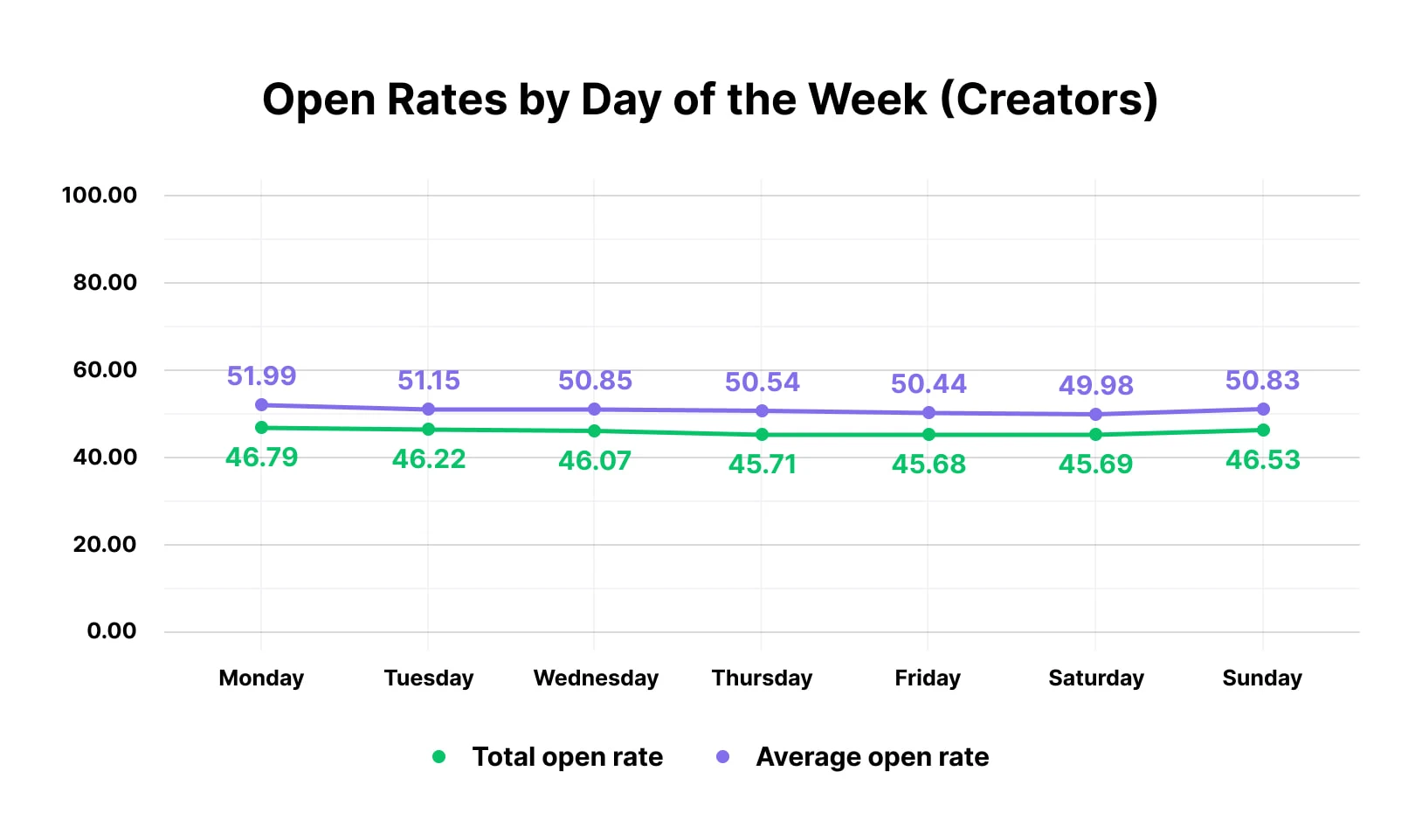
The best day for SMBs to send an email campaign is…
Monday takes the lead again! With slightly lower open rates overall compared to the creator category we found that Monday was yet again the highest performer for open rates with an average open rate of 49.52%. We see a slight reduction in opens on Thursday (47.98%) and Saturday (47.53%) which mirrors our findings from the study overall.
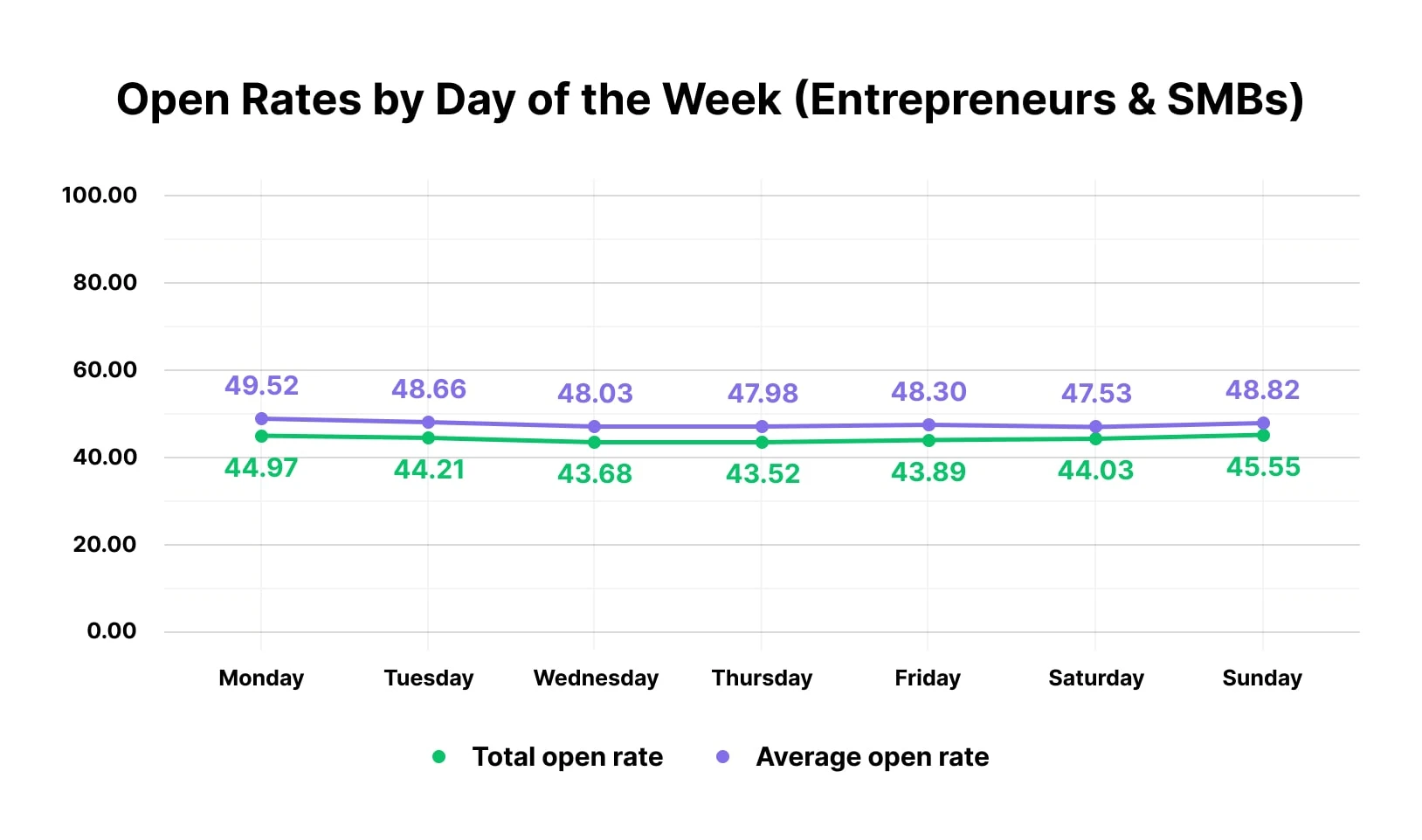
The best day for institutions to send an email campaign is...
Straight out of left field—Sunday! Sunday saw the highest average open rates with a respectable 57.03% closely followed by Monday (56.97%). However, the total number of campaigns sent on Sunday was 14,930 below the average of other days (approximately 35,134). This can explain the higher-than-average open rates we saw on Sunday.

So, when is the best time to send an email?
Our data shows that weekdays outperform weekends in terms of total campaigns sent and total opens. Mondays are particularly effective as campaigns sent on this day have higher than average open rates, which is a new trend compared to last year’s data.
And, while the data isn’t as reliable for the weekends, sending emails on the weekend may result in higher engagement simply because marketers are sending out fewer emails during the weekend.
As for the best time to send an email, we’re seeing a new trend of later opens compared to last year, perhaps suggesting that subscribers are checking their inboxes either at the end of the working day or once they finish.
However, the best way to know when to send an email campaign is to test, test, test! What might work for one audience and industry might not work for you. Make sure you’re running regular tests to see which times are the most successful. Advancements in AI, such as our Smart Sending feature, mean that we’ll start to rely less and less on global optimum times and more on individual subscriber preferences.
Tools to optimize your sending time
Once you’ve analyzed your data and determined the key times to send your newsletters, take advantage of email marketing’s best-sending features. They’ll make your life a whole lot easier!
Smart sending
Smart sending, one of many AI tools available on the Advanced MailerLite plan, is the absolute best way to make sure your emails are arriving at the best time. Your email list is full of real humans with diverse needs and routines. Rather than trying to find the perfect time of day for everyone, let Smart sending individually deliver emails at a custom send time for each subscriber.

Smart sending automatically analyzes historical data to determine the best send time for each subscriber, then continues to analyze and adapt to your audience the more you use it. Pretty cool!
Auto-resend
Most email opens will happen within an hour of arrival. If your message is very important, use auto-resend to re-engage your subscribers without lifting a finger. With this feature, your email will resend automatically to everyone who didn’t open it the first time.
You can add a personalized message to the second email to let people know it’s important. When resending unopened email campaigns, the goal is to make everyone feel as if the second email was designed especially for them.
Deliver emails by time zone
With MailerLite, you can check your ‘opens by location’ to understand where your subscribers are based. When you deliver emails by time zone, you don’t risk delivering newsletters to your international audience at off-peak times. Each reader will receive the newsletter at the same time in their own time zone. Just bear in mind that some location and open tracking may now be affected by Apple Privacy Protection.

Link triggers
Sometimes, you can use automation triggers to send emails at the perfect time. Instead of trying to work out the best time to send a newsletter to your entire email list, link triggers send individual emails based on each subscriber's action.
When a reader clicks on a link in your email campaign, they can trigger another email that matches the topic they are interested in at that very moment. This takes out the guesswork and lets the subscriber's behavior dictate a good time to send your message.
A/B testing and Multivariate testing
Send time isn’t the only factor that influences email open and click rates. Your email subject line, sender address, and email content can also be major players. Fortunately, you can test out these 3 things and more to find out which one generates the most engagement.
A/B testing is where you create 2 versions of the same email (e.g. with different subject lines), and then send them to a sample of your audience. The version that generates the highest opens or clicks* will be declared the “winner” and get sent to the rest of your email list.
Multivariate testing is similar to A/B testing, only it allows you to go much deeper by testing different combinations of variables for a more advanced look into what resonates with your audience.
*Since the Apple Mail Privacy Protection feature was released on 20 September 2021, we recommend A/B testing by click rate rather than open rate.
The truth about email sending times
When all's said and done, sending time is a minor detail in the broader email marketing strategy. Your audience will open and read emails because of the content and value that you provide them with. It’s no good sending your email newsletter at the perfect time if it doesn’t match up with other email marketing benchmarks.
So if a deadline is coming up, and you’re not happy with your email, wait until it’s ready. It’s better to deliver a quality experience, rather than sacrificing it for the sake of a specific date and time. When your readers are looking out for your newsletters with excitement, the timing becomes less relevant.
To wrap up, here are your main email sending time takeaways:
Send your newsletter on weekdays if you want higher open and click rates, and on weekends if you want your audience’s undivided attention
Mondays might now be a better time to send your campaigns—test it out for yourself!
There’s a growing trend of later open rates compared to our data from last year
Make use of email marketing tools to fine-tune your sending, such as auto re-sends and link triggers
Remember: High-quality newsletters are more important than perfect timing
Have you found the perfect sending time for you? Tell us about it in the comments.
Editor's note: This post was originally published in September 2020. It has been updated with new insights from our 2024 data.

